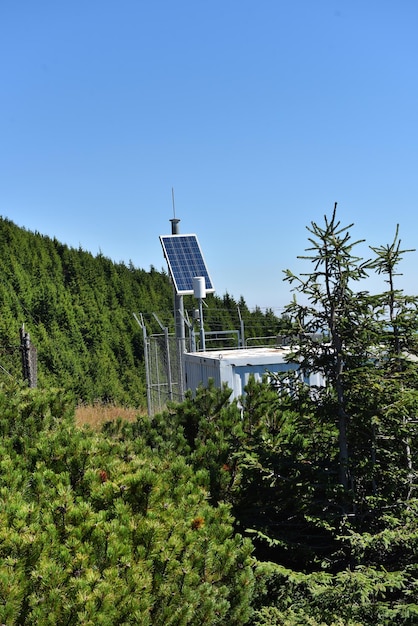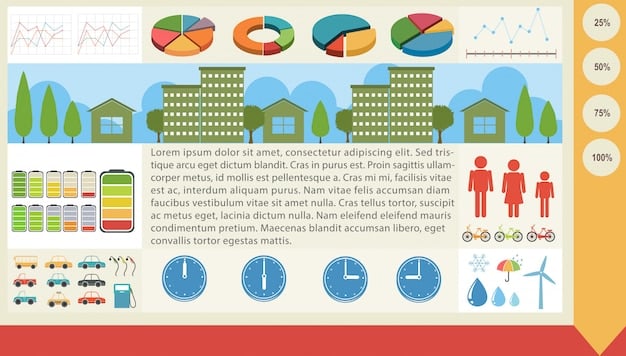Choosing a Renewable Energy Provider: Your 2025 Guide

Choosing the right renewable energy provider involves assessing your energy needs, understanding available plans, comparing costs and environmental impacts, and verifying the provider’s reliability and customer service for a sustainable future in 2025.
Navigating the world of renewable energy can be daunting, but choosing the right provider is a crucial step towards a sustainable future. This comprehensive guide, how to choose the right renewable energy provider: a 2025 comparison guide, is designed to help you make an informed decision.
Understanding Your Energy Needs
Before diving into the comparison of renewable energy providers, it’s essential to understand your current energy consumption. This knowledge will guide you in selecting a plan that aligns with your needs and budget.
Assess Your Current Energy Usage
Start by reviewing your past energy bills to identify patterns in your energy consumption. Are there specific times of the year when your usage spikes, such as during the summer or winter months?
Calculate Your Average Monthly Consumption
Calculate your average monthly energy consumption by adding up your energy usage over the past year and dividing by 12. This will give you a baseline to compare against the offerings of different renewable energy providers.
- Review Past Bills: Analyze your energy bills for the last 12 months.
- Identify Peak Usage: Note any months with unusually high consumption.
- Calculate Average: Determine your average monthly energy usage.
Understanding your energy needs is the first step in choosing a renewable energy provider that meets your requirements. By analyzing your past consumption and identifying patterns, you’ll be better equipped to make an informed decision.

Exploring Available Renewable Energy Plans
Renewable energy providers offer a variety of plans, each with its own set of benefits and drawbacks. Understanding the different plan types is crucial to finding the best fit for your needs.
Fixed-Rate Plans
Fixed-rate plans offer a stable energy rate for a set period, providing predictability in your monthly bills. This can be a good option if you prefer to avoid price fluctuations.
Variable-Rate Plans
Variable-rate plans offer rates that fluctuate with market conditions, which can result in lower prices during certain times of the year but also expose you to potential price spikes.
Green Energy Plans
Green energy plans guarantee that a certain percentage of your energy comes from renewable sources, such as solar, wind, or hydropower. These plans often come with a premium but can be a good option if you prioritize sustainability.
- Fixed-Rate: Stable rates for a set period.
- Variable-Rate: Rates fluctuate with the market.
- Green Energy: Energy sourced from renewable sources.
Exploring the available renewable energy plans is essential to finding the best option for your needs and preferences. Each plan type offers its own set of advantages and disadvantages, so it’s important to weigh your priorities carefully.
Comparing Costs and Environmental Impact
Cost and environmental impact are two key factors to consider when choosing a renewable energy provider. Balancing these factors can lead to a sustainable and affordable energy solution.
Analyze Pricing Structures
Carefully analyze the pricing structures of different providers, paying attention to any hidden fees or long-term contracts. Compare the cost per kilowatt-hour (kWh) and consider any additional charges for renewable energy credits.
Assess Environmental Benefits
Consider the environmental benefits of each provider, such as the percentage of renewable energy they source and their overall carbon footprint. Look for providers that invest in renewable energy projects and promote sustainable practices.

Comparing costs and environmental impact is a crucial step in choosing a renewable energy provider that aligns with your values and budget. By analyzing pricing structures and assessing the environmental benefits, you can make an informed decision that supports sustainability and affordability.
Cost Considerations to factor in:
- Kilowatt-hour (kWh) rate: Price you pay for each unit of energy consumed.
- Monthly fees: Fixed charges applied regardless of energy consumption.
- Contract length: Consider the duration of the agreement and potential early termination fees.
Evaluating Provider Reliability and Customer Service
Reliability and customer service are critical aspects to consider when selecting a renewable energy provider. A reliable provider ensures a consistent energy supply, while excellent customer service can address any issues that may arise.
Check Provider Ratings and Reviews
Research the ratings and reviews of different providers to gauge their reliability and customer service quality. Look for feedback on factors such as billing accuracy, responsiveness to inquiries, and overall customer satisfaction.
Assess Grid Integration and Backup Options
Assess how well the provider integrates with the existing energy grid and whether they offer backup options in case of power outages. Providers with robust grid integration and backup systems can provide a more reliable energy supply.
Choosing a reliable renewable energy provider requires careful consideration of ratings, reviews, and grid integration. By prioritizing these factors, you can ensure a consistent energy supply and excellent customer support when needed.
Understanding Renewable Energy Credits (RECs)
Renewable Energy Credits (RECs) are a crucial instrument in the renewable energy market. They represent the environmental attributes of electricity generated from renewable energy sources.
What are RECs?
RECs, sometimes called green tags, are tradable, market-based instruments that certify the bearer owns one megawatt-hour (MWh) of electricity generated from a renewable energy resource. These resources could include solar, wind, geothermal, biomass, and low-impact hydro.
How RECs Work
When a renewable energy generator creates electricity, it also creates RECs. It can then sell these RECs separately from the physical electricity. This allows utilities or individuals who want to claim the use of renewable energy to purchase these credits and offset their carbon footprint without needing to generate the energy themselves.
Future Trends in Renewable Energy
The renewable energy landscape is constantly evolving, with new technologies and trends emerging each year. Staying informed about these developments can help you make a more informed decision when choosing a renewable energy provider.
Advancements in Solar and Wind Technology
Solar and wind technologies are becoming more efficient and affordable, making them increasingly attractive options for consumers and businesses alike. Keep an eye on advancements such as bifacial solar panels and taller wind turbines, which can generate more energy in less space.
Integration of Energy Storage Solutions
Energy storage solutions, such as batteries, are becoming more common in renewable energy systems, allowing consumers to store excess energy for later use. This can increase energy independence and reduce reliance on the grid.
| Key Point | Brief Description |
|---|---|
| 💡 Energy Needs | Assess your current energy usage to choose the right plan. |
| 💰 Cost Analysis | Compare pricing structures and consider hidden fees. |
| 🌱 Environmental Impact | Assess the environmental benefits and sustainability practices. |
| ⭐ Reliability & Service | Check ratings, reviews, and grid integration for a consistent supply. |
Frequently Asked Questions (FAQ)
▼
The main types of renewable energy plans include fixed-rate plans, which offer stable pricing; variable-rate plans, which fluctuate with the market; and green energy plans, which guarantee renewable energy sourcing.
▼
To assess your energy needs, review your past energy bills for the last 12 months, identify months with peak usage, and calculate your average monthly energy consumption to establish a baseline.
▼
Renewable Energy Credits (RECs) are tradable instruments that represent the environmental attributes of electricity generated from renewable sources, certifying that you own one megawatt-hour of renewable energy.
▼
Evaluate provider reliability by checking ratings and reviews, assessing grid integration, and considering backup options. Look for feedback on billing accuracy and responsiveness to inquiries.
▼
Keep an eye on advancements in solar and wind technology, the integration of efficient energy storage solutions, and developments in smart grid technology for more informed decisions.
Conclusion
Choosing the right renewable energy provider for 2025 involves several key considerations, from understanding your energy needs and comparing available plans to evaluating provider reliability and staying informed about future trends. By carefully assessing these factors, US residents can make a sustainable and informed decision that aligns with their values and budget,contributing to a greener future.





